2025 Portugal Pro: Final Highlights – Waterski Pro Tour Stop 6
Catch all the excitement from the finals of the Portugal Pro.
Catch all the excitement from the finals of the Portugal Pro.
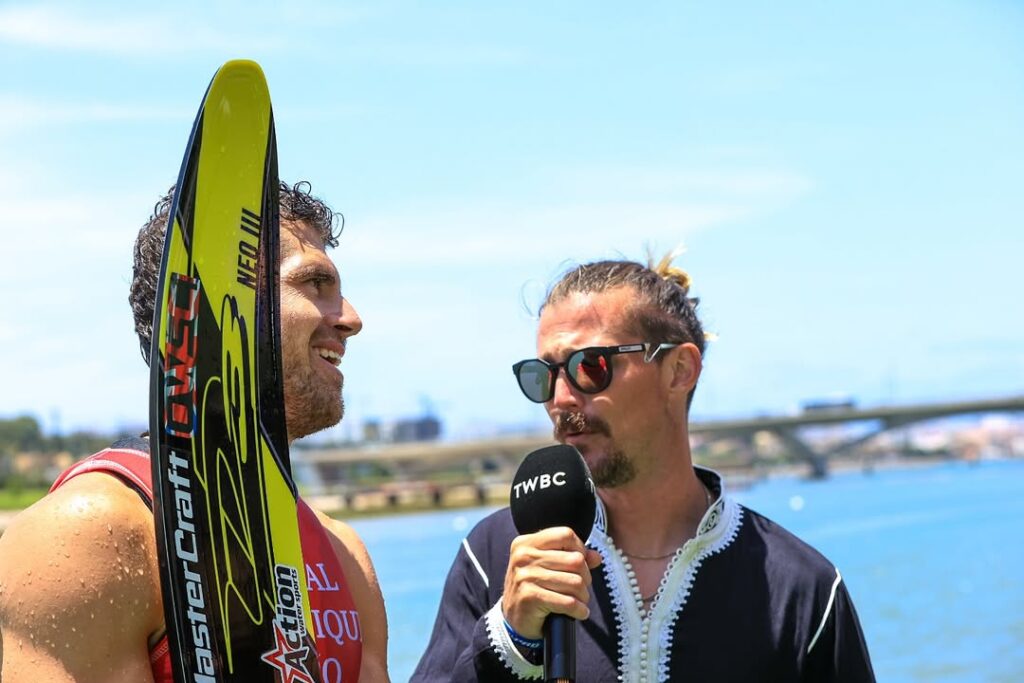
Image: @thomasgustafson
When the Tour landed in Marrakech, Morocco in the middle of last June it broke new ground for waterskiing. Until that day there had never been a professional event held on the continent of Africa. And what a first event it was. Hospitality was on a new level, as were the scores – we saw the first 10.25m/ 41off pass completed in 2024 and, simultaneously, in Africa – and the coverage from the wild desert outside Marrakesh from TWBC (also event organizers) was typically stellar. One could have been forgiven for wondering: how can the organizers follow this?
Well, very simply, they went bigger. The Royal Nautique Pro – so named because of its association with the Royal Nautique Club on the Bou Regreg river – had more disciplines with the addition of tricks and a far more ambitious venue. Last year’s remote man-made lake outside Marrakech was replaced by a tidal river directly in the center of the city of Rabat, between high-end hotels and the newly built Grand Theatre. More spectacle was on offer also, with a synchronised drone show that will likely never be topped in waterskiing for surprise – think animated waterskiers moving through the air followed by messages in the sky and tournament logos.
Of course the tidal river – so close to the sea that many skiers taxied just a mile up the road for a post-event surf session at the estuary – brought a unique challenge. Many of the athletes present have competed at the Moomba Masters in March of each year but the Yarra river has a peak current of a small handful of mph. In Rabat it was many multiples of that. Wind was a factor also on the wide open river, typically starting low and increasing throughout the day. After practice there were some concerned faces. With skiers so used to bespoke man-made lakes in the middle of nowhere, the curveballs of the venue would be a challenge. But, as many mentioned on the broadcast coverage, the sport needs diversity in its events to remain interesting and this could not fit the bill more.
Across two qualifying rounds, despite the challenging conditions, the standard was, perhaps surprisingly, high. On the men’s side it took a pair of 3s at 10.75m to make the final. Tim Tornquist was unfortunate to be first out with a 3 and a 2. Corey Vaughn topped the bill with 2@10.25m, heroically showing big scores were possible on the river. Jaimee Bull had earlier done the same, just missing her exit gate as she lost balance having stroked a 10.75m pass.
The trickers field had two seeding rounds to get used to the water, with scores into 10k and 11k by the women and men respectively. In the end Anna Gay, the class of the field all weekend triumphed, scoring just over 10,000. On the men’s side Pato Font ultimately took the win in the final with a huge 12,390. With consecutive wins in Monaco and now Morocco, Font’s resilience, after a disappointing 18 months or so having previously been undefeated for years, is commendable and another string added to his already impressive bow.
Jaimee Bull also took her second win of the season, winning every round. Last off the dock, she did enough by rounding 2 at 10.75, holding off TWBC’s audience-voted Skier of the Day Neily Ross who ran 1 early in the final. Allie Nicholson, never not a podium threat and winner at last year’s event, took third place with 5 at 11.25m. Bull, who was disappointed to lose the inaugural title last year, took her place as Queen of Africa.
The men’s final saw changing conditions as the tide changed. The risk of starting at 12m and taking 11.25m the trickier head current/ tail wind direction to have 10.75 the supposedly easier way resulted in split skier strategies. In the end only Freddie Winter and Corey Vaughn, who used it so successfully in the first round, rolled the dice. It came off for Winter, who scored 1.5@10.25m and then waited to see top seed Vaughn fall halfway down 11.25m to give him the title, his first on the Tour since catastrophically breaking his leg at Monaco less than a year ago.
In so many ways, these sorts of events don’t come along very often. Many comments from the pro waterski fanbase around the web mentioned their enjoyment of seeing the top skiers, usually so adept and graceful, seem human in their struggle in the conditions. But it should be noted that despite the huge tides, the big wind and the salty water, there were scores out on the river that would have won many pro events not so long ago. To do so in front of such scenery, in the capital of such a great country, in a continent still new to waterskiing, was exceptional to see. We couldn’t be more excited for next year’s event.
Catch all the excitement from the finals of the Royal Nautique Pro.
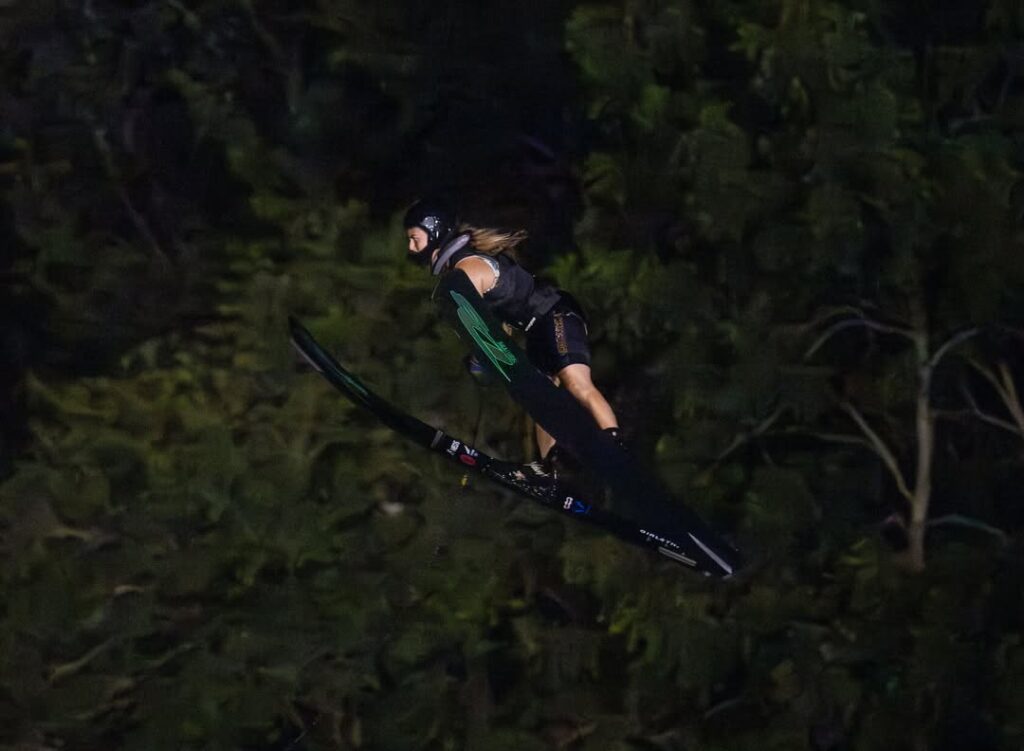
Image: @lanightjam
By Jack Burden
Last weekend, some of the world’s best jumpers went soaring under the lights in Zachary, Louisiana. The LA Night Jam had it all: a packed shoreline, festival energy, world champions, rising stars, and Waterski Pro Tour points on the line.
But unless you were there in person, you didn’t see a second of it.
There was no webcast. No slo-mo replays. No expert commentary. No drone shots capturing heroic flight. Just the dry final results, posted to an anachronistic website after the spray had settled—black-and-white numbers standing in for what was, by all accounts, one of the most electric nights of the season.
And for diehard fans like me, that felt like a gut punch.
In the post-COVID era, we’ve grown used to watching every pro event live, for free, from anywhere in the world. The quality of these broadcasts has never been better, thanks in large part to The Waterski Broadcasting Company (TWBC). But cracks are starting to show in that model—and there’s a quiet, potentially growing shift away from relying on livestreams to carry the weight of an event.
Two of the four stops on the 2024 WWS Overall Tour were not broadcast, including the Canada Cup, which doubled as a Waterski Pro Tour jump stop and delivered some of the season’s most thrilling competition. The Fungliss ProAm, with the richest men’s slalom purse of the year, also eschewed a webcast.
Why? Because streaming costs money. And despite loyal viewership, the audience hasn’t really grown. TWBC’s YouTube views have plateaued since 2020. The downgrade of the Swiss Pro Slalom—still the most-watched water ski webcast every year—drives the point home: if the sport’s most visible livestream can’t generate enough sponsor revenue to stay on tour, something’s broken.
Still, many—including me—believe high-quality webcasts are a worthwhile investment. Maybe the audience isn’t there yet. But what better vehicle exists to grow the sport long-term? Who else is grinding to tell skiing’s story with the polish and persistence of TWBC?
That doesn’t mean, though, that every tournament needs to look the same.
The LA Night Jam reminds us there’s another way—one rooted in the past, but maybe just as vital to the future.
Rather than catering to a global digital audience, LA Night Jam pours its resources into the on-site experience. It’s a deliberate throwback—a water ski festival, as event coordinator Tucker Johnson described it in a local TV interview: “It’s fun for the whole family… a pro tournament set up with tons of events around it as well.”
There are trick exhibitions. Slalom head-to-heads. Freestyle skiers. Adorable kids on combos. In one memorable stunt, someone even barefooted out of a hot air balloon. It’s all designed to dazzle the crowd—many of whom arrive knowing nothing about water skiing and leave wanting more.
The funding model reflects that philosophy. Instead of relying on industry sponsors trying to reach a global audience, the event is backed by local businesses. Their website, perhaps vindictively, notes that the “event is not sponsored by MasterCraft Boat Co.”—a nod to the departure of their former headline sponsor and the pivot toward a community-first approach. It’s a stark contrast to the traditional, industry-funded model.
Here, the crowd isn’t just a backdrop. It’s the point.
And LA Night Jam isn’t alone. The 2024 WWS Canada Cup followed a similar formula: local crowd, local sponsors, no webcast. We’ve also praised the King of Darkness for its festival-like atmosphere and crowd engagement—though that event still pairs its in-person spectacle with a top-shelf livestream.
These formats don’t just recycle the same core audience—they expand it. They draw in new families, new eyeballs, and potentially new sponsors. Yes, physical crowds come with constraints—parking, logistics, capacity. But they offer something livestreams haven’t cracked yet: the ability to convert the curious into the committed.
As reigning world champion Freddie Winter put it recently on the TWBC podcast: “We shouldn’t just be skiing in backyard tournaments… getting in front of people is also fantastic.”
Back when waterskiing was booming, it had both—crowds and broadcasts. Passion and reach.
So maybe it’s not about choosing one or the other. Maybe it’s about trying everything, everywhere, all at once. Because if there’s one thing the sport can’t afford right now, it’s to put all its eggs in one basket.
It’s become cliché to quote the line about insanity being doing the same thing over and over while expecting different results. But it’s worth reflecting on. TWBC has poured heart and soul into their livestreams. And while their numbers are respectable, they haven’t meaningfully grown in five years. Meanwhile, their side projects like The Unknown Sport of Waterskiing and The Rise of Waterskiing arguably have the greatest potential of breaking through to new audiences.
At the same time, LA Night Jam and others like it are bringing fresh energy, new money, and new eyeballs into the sport—and paying athletes in the process.
With only five pro jump events on the 2025 calendar, every one counts. The fact that LA Night Jam delivered a full purse without a webcast isn’t a failure—it’s a sign of creativity and resilience.
So maybe the real takeaway is this: not everything in waterskiing needs to be built for people like me. Sometimes the best thing we can do for the sport is reach someone who’s never seen it before. Ideally, yes, we’d have both—a packed shoreline and a global livestream. But if resources are limited, I’m glad events are experimenting.
Throw enough at the wall, and something might just stick.
The future of water skiing won’t come from clinging to one tournament model. It will come from daring to try new ways to bring the sport to life.
If that means leaving some fans in the dark—so be it. But if it means lighting up a new generation, then the gamble is worth it.
Note: An earlier version of this article incorrectly implied that the Lake 38 ProAm had shifted away from TWBC for budget reasons. In fact, TWBC was the organizers’ first choice, but was unavailable due to scheduling conflicts.
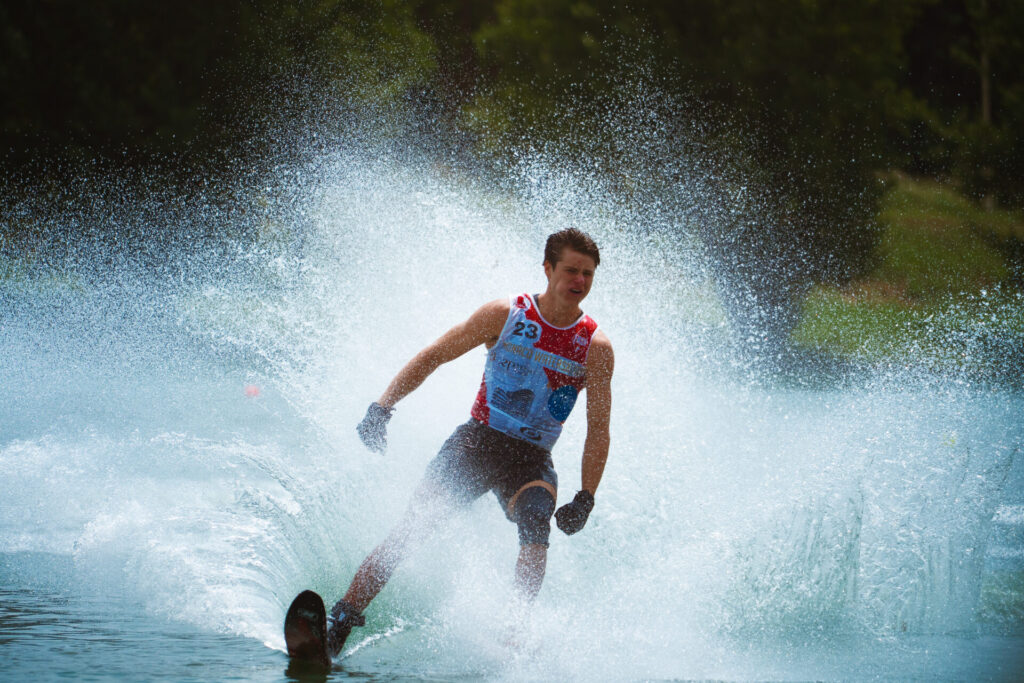
Image: Arthur Sayanoff
By TWBC
For the first time ever, TWBC made an appearance at the Monaco Waterski Cup in Roquebrune Sur Argens, France. The event was hosted by the Monaco Water Ski Federation and organized by Greg Desfond and Alexis Keusseoglou. These two absolutely killed it with a wonderful skiing setup, engaging format, top tier food, and homages to Monaco’s racing heritage. Greg and Alexis were so committed to the overall experience that they even arranged to have a retired F1 car displayed near the spectator seating. Additionally, they partnered with Fast Lane Drive to have a wide array of exotic vehicles displayed along the shoreline. How’s that for yard decoration?
As cool as the theme was, that’s not the real reason people showed up. The skiing was easily the main event with some incredibly competitive moments, a fair share of drama, unpredictable conditions, and even a pending world record. This year’s event featured both slalom and trick, with a special twist implemented in the trick division. It’s been a running theory that trick is the only of the three skiing events where men and women are on an even playing field. Well the Monaco Waterski Cup decided to put that to the test and formed one combined division for all of the interested trick competitors. In total, 8 trickers opted in to try the fused division, including some first time Waterski Pro Tour participants. The most interesting part… if placements lined up with seeding, we would have a mixed gender podium.
Full article at The Waterski Broadcasting Company
Catch all the excitement from the finals of the Monaco Waterski Cup.
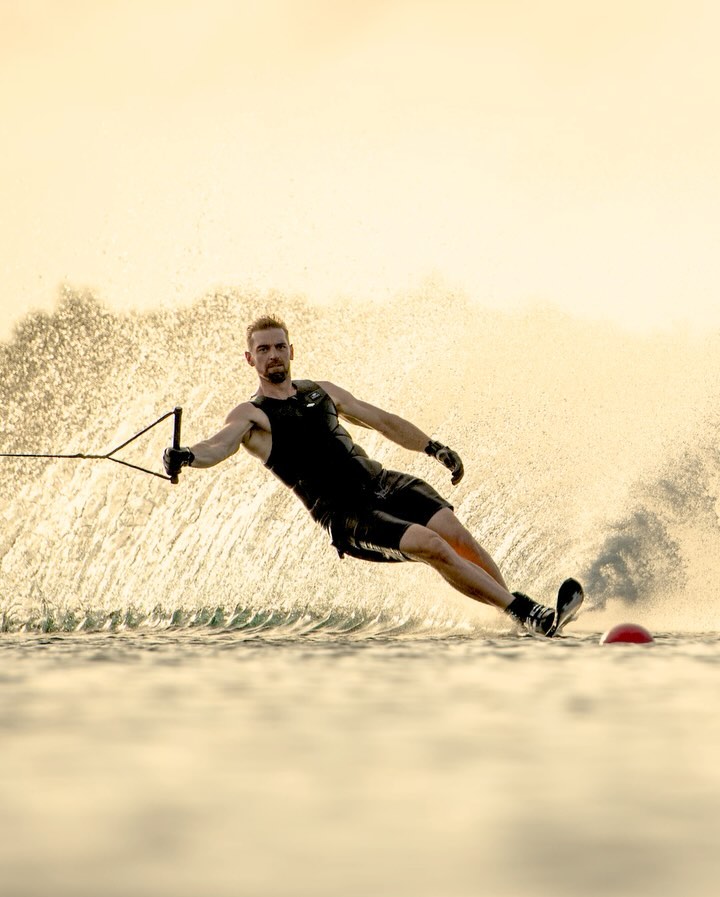
Image: @jmommer2
By Jack Burden
In the early morning glass of a Florida lake, Will Asher slices the slalom course like a man trying to solve a riddle only he can hear. At 42, he shouldn’t be this vigorous. But this ride isn’t just about winning—it’s about understanding.
That understanding, it turns out, might be the only thing keeping him going.
In a season that was supposed to mark the rise of the next generation, it was the old master who stood tallest. Asher, already a two-time world champion and one of the most decorated slalom skiers of all time, didn’t just show up in 2024—he took over. Four professional wins, more than double the next closest competitor. A three-stop sweep through Morocco, the south of France, and Monaco, where he ran 10.25 meters (41’ off) not once, but twice. Against men half his age, Will Asher was untouchable.
Ask what changed, and he doesn’t talk about dominance—he talks about freedom.
“We made a breakthrough [with my equipment],” he said in a recent episode of the FPM Podcast with Marcus Brown. “And when you get to that point, you’re able to just switch off.”
There’s a calmness to Asher now—a kind of peace forged not by slowing down, but by refining his purpose. In a sport where most of his contemporaries have long since moved on, he’s still here. Still evolving. Still building.
What do you do when you’ve won almost everything? For Asher, the answer wasn’t to walk away. It was to go deeper.
Ski design—once a curiosity, now an obsession—has become his new frontier. His latest creation, the Syndicate Works 01, isn’t just a ski. It’s the result of a decade-long search for feel, feedback, and flow. A physical manifestation of everything he’s learned—and everything he still doesn’t know.
For Asher, it’s not about tournament wins anymore. It’s about chasing the perfect feel.
And it’s not just about his performance. It’s about the craft. The satisfaction of building something that matters.
“It’s like my babies,” he says. “Thousands of my children out there that people are trying to experience. And it does feel good when people say, ‘That changed my life.’ That’s their release. Their enjoyment. Their pleasure.”
This isn’t legacy-building. It’s presence. Pride. Passion shared.
Asher often speaks of skiing as more than sport. It’s structure. It’s meaning. A daily ritual that gives shape to life.
“Yeah,” he says, when asked if skiing brings purpose. “It keeps me on the straight and narrow. Keeps me motivated. Gets me up in the morning. Makes me go to bed. Make good decisions… most of the time.”
But underneath the laugh is something harder. At 42, he knows his competitive days are numbered. And he’s honest about what comes next.
“Essentially a piece of me is going to die,” he says. “We don’t see the timer, but we know there’s a timer. [Maybe] this year, maybe next year, it could happen next week.”
Then, more quietly: “And when people put their whole life into one thing and it suddenly goes away—it’s full of depression and anxiety. You’ve got to fill that hole, right?”
That’s the part athletes don’t talk about. The collapse waiting just off-stage. The slow erasure of identity. For Asher, the antidote isn’t legacy. It’s curiosity.
“I think specialization is a terrible thing,” he says. “[It’s] one of the worst things that can happen for the potential of a child in athletics. I don’t understand why it’s not also true for adults.”
He finds refuge in other routines: cycling, lifting, running, foiling. “It’s like my kind of therapy,” he says. “To get away from everything.”
Even his on-water habits reflect that mindset. “I will actively go out of my way to not ski with people that are just too obsessed and cannot switch it off.”
Another form of escape? R&D.
Asher’s work with HO Skis has become a space beyond the slalom course. A place where he can tinker, rebuild, and reimagine what a ski can be.
He talks about design with reverence. Like a miner chasing gold.
“You know there’s gold down there,” he says. “You’ve done the tests. You’ve done the experiments. You see it—it’s there. But you still have to go dig it out.”
That treasure—the perfect ski—remains elusive. And maybe that’s the point.
“As crazy as it may sound, after 20 years I’m still trying to understand the basics,” he says. “It’s unbelievable how many variables there are in just one ski.”
Flex. Rocker. Width. Concave. Materials. Layup. The way a ski flexes and twists. It all matters. And yet, no formula guarantees feel.
“On paper, you can maximize everything. [But] if you maximize everything, that thing doesn’t work,” he says. “You can get performance, but sometimes it’s almost scary. To actually go to that place on the ski—it’s not comfortable.”
Still, he chases it.
“I feel like it’s my life’s work to get all that to come together into one place.”
It’s not just theory. Asher’s skis are reshaping how elite skiers approach the sport. Team Syndicate riders won more than 40% of all professional slalom titles last season, with roughly the same share of podiums. An extraordinary haul in a field where seven different ski brands earned at least one win.
Less rigidity. More feel. Less fear. More flow.
The lab has become a second course. A proving ground for risk and reinvention.
Because perfection isn’t really the point. The point is to keep going.
What’s most remarkable about Asher isn’t the titles—though there are plenty. It’s that, two decades in, he still believes there’s something essential left to discover. That his life’s work isn’t a résumé of wins, but a trail of questions.
And that legacy is starting to echo—in younger skiers looking beyond the podium. In those chasing meaning, not just medals.
That’s Will Asher’s influence. Not just as a champion. But as a craftsman. A philosopher of flow. A man still mid-process.
Back on the lake, Asher is testing again. Not skiing for scores, but for feel. Riding a prototype. Making notes. Chasing something invisible.
It’s not about being the best anymore. It’s about staying unfinished.
Because the perfect ski—like the perfect run—probably doesn’t exist.
But if you spend your life looking for it… maybe that’s enough.
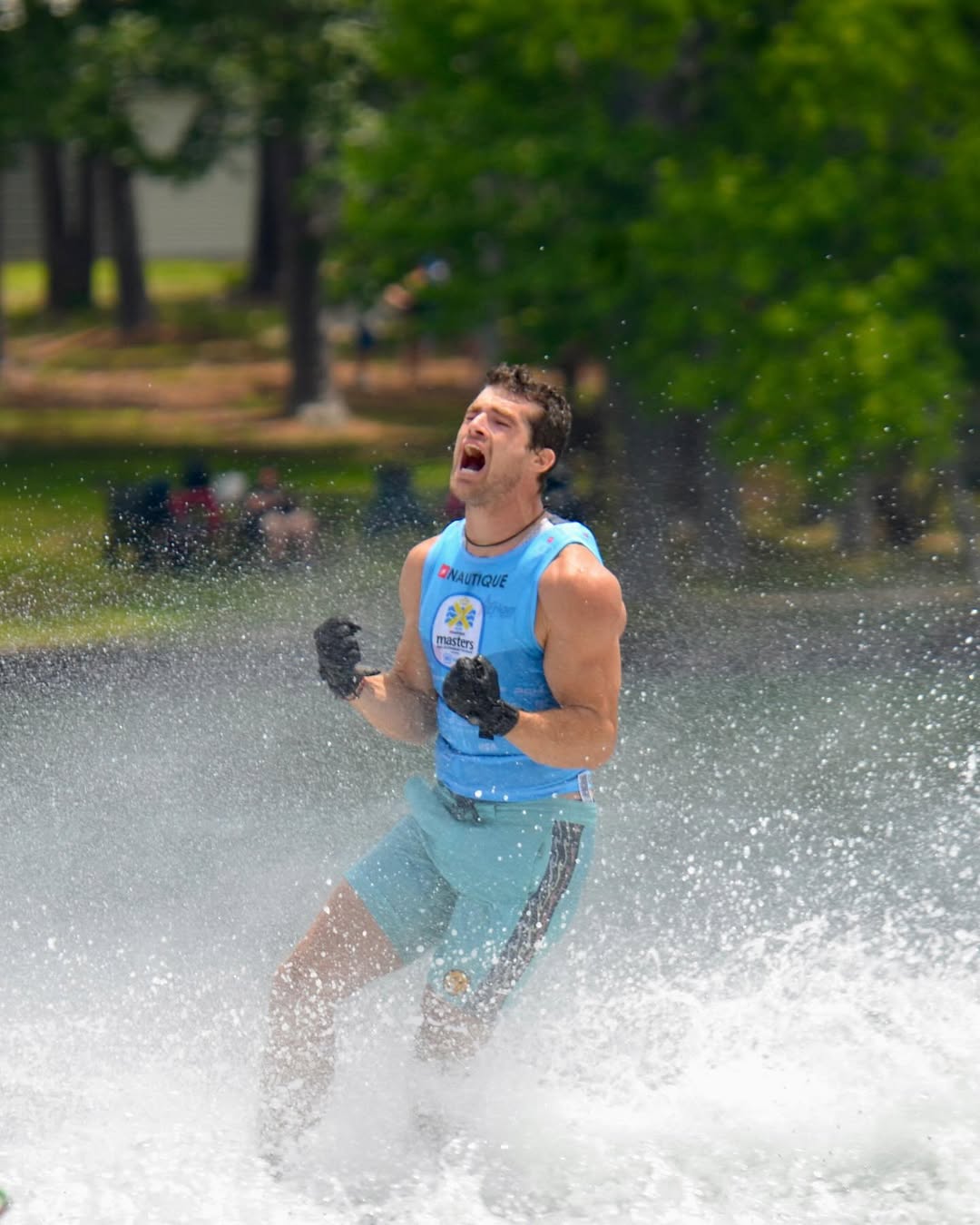
Freddie Winter celebrates his victory in men’s slalom (image: @bretellisphotography)
By Jack Burden
PINE MOUNTAIN, Ga. — The 65th Masters Water Ski & Wakeboard Tournament wrapped up Sunday beneath the tree-lined shores of Robin Lake, with records, redemption arcs, and rare feats all leaving their mark on one of the sport’s most storied stages.
History doesn’t just hang in the air at Callaway Gardens—it breathes down your neck. From the stirring boat parade to the veteran-honoring ceremonies, the Masters isn’t just a tournament; it’s a stage where legacies are made, and occasionally, broken. And this year, they cracked wide open.
Let’s start with the history on Friday. Germany’s Tim Wild delivered a performance for the ages, sweeping all four Junior Masters titles: slalom, tricks, jump, and overall. In doing so, he became the first male ever to achieve the sweep and only the third skier in Junior Masters history to pull it off—joining legends Regina Jaquess and Brandi Hunt. Wild’s path to perfection included victories over multiple reigning junior world champions and a tricks field featuring the 12,000-point club’s newest member.
By the end of Saturday’s brutal semifinals—where 45 skiers battled for just 12 final spots per gender—much of the sport’s royalty had been dethroned. Patricio Font. William Asher. Whitney McClintock Rini. Jaimee Bull. Gone. In their place: hungry challengers, career comebacks, and a few bold debutantes.
Sunday’s finals opened with one of the most anticipated showdowns, with the intensifying battle between Erika Lang and Neilly Ross for the world record expected to play out real time on the waters of Robin Lake.
Lang continued her stranglehold on the division, scoring 10,530 points to win her sixth Masters title. Her record in professional events since the start of 2023 now extends to 10 wins in 12 tournaments—including all three this year: Moomba Masters, Swiss Pro Tricks, and now the U.S. Masters.
Yet in many ways, it was Germany’s Giannina Bonnemann Mechler who stole the spotlight. Making a triumphant return to the podium less than a year after giving birth, she edged out defending champion Anna Gay Hunter and world record holder Ross with back-to-back 10,000+ scores.
In the men’s tricks final, Jake Abelson proved that last year’s world record was just the beginning. He threw down 12,190 points to win his second major title of 2025—a leap of faith rewarded after skipping Junior Masters eligibility to compete in the Open division.
“A dream come true,” shared the 17-year-old after his victory.
Joel Poland’s third-place finish may have come as a shock. After two stand-up passes and an exuberant celebration from the Brit—the top seed and last skier off the dock—the announcers couldn’t call it between Poland and Abelson, speculating, “I think it’s going to be extremely close, only a couple hundred points that separate them.”
But the final score told a different story: more than 1,500 points separated the two. Judges scrubbed multiple tricks from both of Poland’s runs—but even if all had been credited, his score still wouldn’t have caught Abelson’s winning mark. Nevertheless, the apparent controversy may have lit a fire under Poland for what came later.
If tricks was about cementing legacies, slalom was about redemption.
For the women, 41-year-old Vennesa Vieke, who seems to get better with each passing year, set the pace early with a gritty 1.5 @ 10.75m (39.5′ off). Her mark held through challenges from defending champion Jaquess and Ross. Then came Allie Nicholson, navigating the minefield to a clean 2 @ 10.75m—and her first Masters title.
Arguably the hardest-working skier in professional slalom today, Nicholson has competed in more pro events over the past two years than anyone—male or female. Often stuck behind the dominant trio of Bull, Jaquess, and McClintock Rini, she looked composed as the final skier off the dock—doing exactly what was needed to take the win and perhaps signaling a long-awaited sea change.
The men’s final? Pure Hollywood.
He was banned. He was broken. But now, he’s back.
Less than a year ago, Freddie Winter suffered a potentially career-ending injury—a shattered femur from a crash. Adding to the drama: he had been banned from the 2023 Masters for alleged unsportsmanlike conduct in 2022.
Now, back on Robin Lake, the fiery Brit skied like a man on a mission. Chasing a lead score of 2 @ 10.25m set by world record holder Nate Smith, Winter—last off the dock—threw himself outside of three ball for the win. His third Masters title. His sweetest yet.
“Probably the most emotional moment of my life,” Winter said. “So much self-doubt and fear I wouldn’t get back here over the last 10 months and 29 days.”
“I’ve won here before, but those meant nothing compared to this.”
In women’s jump, a Hanna Straltsova victory often feels inevitable in the post-Jacinta Carroll landscape. But this one felt anything but secure.
Americans Lauren Morgan and Brittany Greenwood Wharton came out swinging in prelims with 174- and 175-foot jumps, respectively—easily outdistancing Straltsova’s 169.
Then, skiing early in the finals, Straltsova posted 53.6 meters (176′). The door was open, but neither Morgan nor Wharton could capitalize.
“You are never prepared enough for the Masters,” shared a reflective Straltsova. “It shows you your weak points and teaches you lessons every time you come.”
Then came the grand finale.
Remember: Poland barely made the final, edging Louis Duplan-Fribourg by a single foot. First off the dock, he put any questions about his jump form to rest—launching a monster 70.1-meter (230′) leap to lay down a massive target.
The remaining finalists—Luca Rauchenwald, Igor Morozov, and Ryan Dodd—all charged hard at the lead. Poland watched nervously from the pavilion.
“Anticipation was 11/10,” he said. “Felt sick waiting for the results.”
Dodd, the world record holder and reigning world champion, came closest. But when the Canadian passed on his final attempt, Poland had his win—and a statement. It’s now been over a year since Dodd claimed a professional title, and the pressure is mounting ahead of his bid for an unprecedented sixth straight world championship.
By sunset, the story was clear. This wasn’t just another Masters. This was a turning point.
From milestone performances to long-awaited redemption, the 65th Masters was a showcase of resilience, risk, and razor-thin margins. And with the debut of the 2026 Ski Nautique onsite—complete with on-air walkthroughs—the event also hinted at what’s next.
For now, the numbers are in, the titles awarded, and the world’s best return to the road—leaving behind another unforgettable chapter on Robin Lake.
And the summer? It’s just getting started.
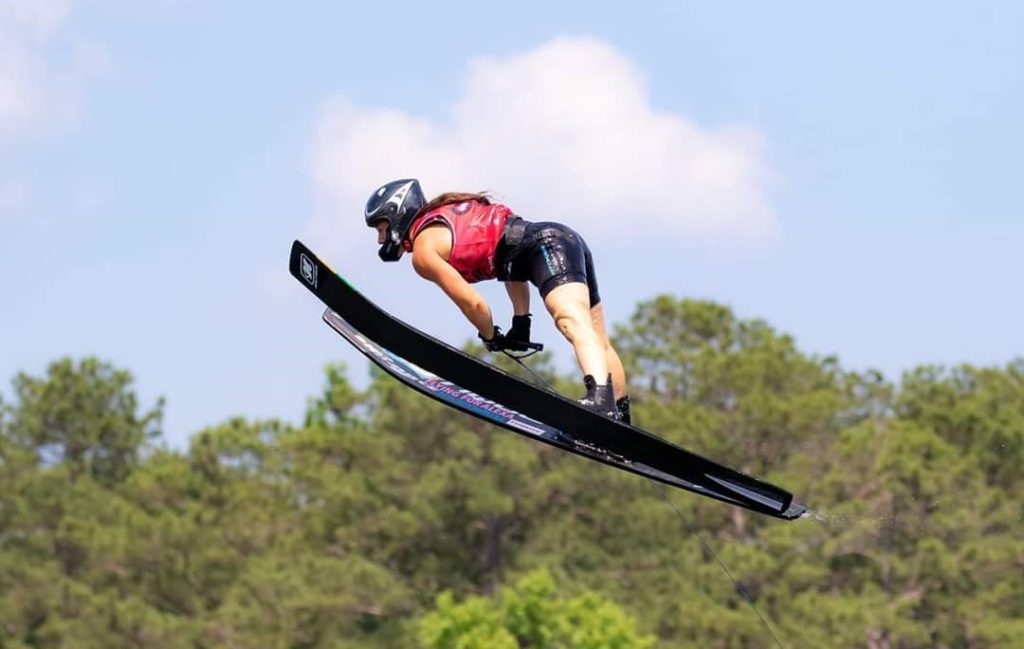
Image: Ian Staples
By RTB
5 minute play
In this quiz, you have to name the female skiers with the most consecutive U.S. Masters titles of all time.
The list contains 14 skiers across 21 different streaks, all of whom have won at least three consecutive titles. Two jumpers are tied for the longest streak with seven titles back-to-back. We have mentioned the event and years of their consecutive titles.

Spotlighting waterskiing’s champion moms for Mother’s Day
By Jack Burden
When we talk about mothers, it’s easy to reach for words like strength, sacrifice, and love. But some mothers go a step further — they don’t just juggle the demands of parenting; they shatter records, hoist trophies, and tilt the axis of their sport. In the high-speed, high-skill world of professional water skiing, these women have shown that motherhood isn’t a hurdle. It’s rocket fuel.
Water skiing has always been a family affair — a sport where weekends on the lake spark lifelong passions and where the dock is as much a playground as it is a battleground. Yet these women have carved more than just slalom courses. They’ve carved new narratives. From toppling outdated assumptions to commanding podiums on the world’s biggest stages, they’ve proven that athletic prime and parenting aren’t mutually exclusive. In honor of Mother’s Day, here are five extraordinary water ski moms whose performances redefine what’s possible.

Image: @whitrini
A decade ago, she was water skiing’s “Golden Girl.” Today, she’s a golden mom — and still one of the sport’s fiercest competitors. After giving birth to her son, Zane, in 2020, McClintock Rini returned to the pro tour the following season as if motherhood was just another notch on her belt. Over the past four years, she’s captured a dozen professional titles and has consistently ranked among the top three slalomers in the world, winning roughly one out of every three events she enters.
Her résumé reads like a chronicle of dominance: five world titles, a world slalom record, and countless professional victories. Her reign at Australia’s Moomba Masters — where she claimed her tenth slalom title earlier this year — is the stuff of legend. And now, with Zane often cheering lakeside, she’s showing no signs of slowing down.

Image: @trueloveski
If resilience had a face in women’s slalom, it might be Karen Truelove’s. The American is arguably the most impressive mom on this list, competing well into her 40s and holding the distinction of being the eldest woman to win a professional title. After giving birth to her son Dash in early 2009, Truelove returned midway through the same season, closing it out with two victories and two runner-up finishes. Five years later, at 40 and just months after welcoming her second son, Ridge, she was still climbing podiums and collecting medals.
One of the most decorated slalomers in the sport, she remains a blueprint for longevity and grit — and now watches her own sons begin their ascent in the junior ranks.

Image: @vennesavieke
Some athletes peak young. Vennesa Leopold Vieke rewrote that script after becoming a mom. Before giving birth to her daughter in 2017, the Australian had just one professional podium to her name. Since then, she’s blossomed into one of the most consistent women’s slalom skiers on tour — notching regular podium finishes while balancing life with her two children, Riverlee and Ezra.
Her crowning achievement came in 2022, when she clinched victory at the Moomba Masters — a moment that cemented her transformation from promising talent to seasoned champion. Her Waterski Pro Tour standings over the past four years (9th, 12th, 10th) tell the story of a competitor not just hanging on but thriving well into her prime — long after many would have expected her to fade.
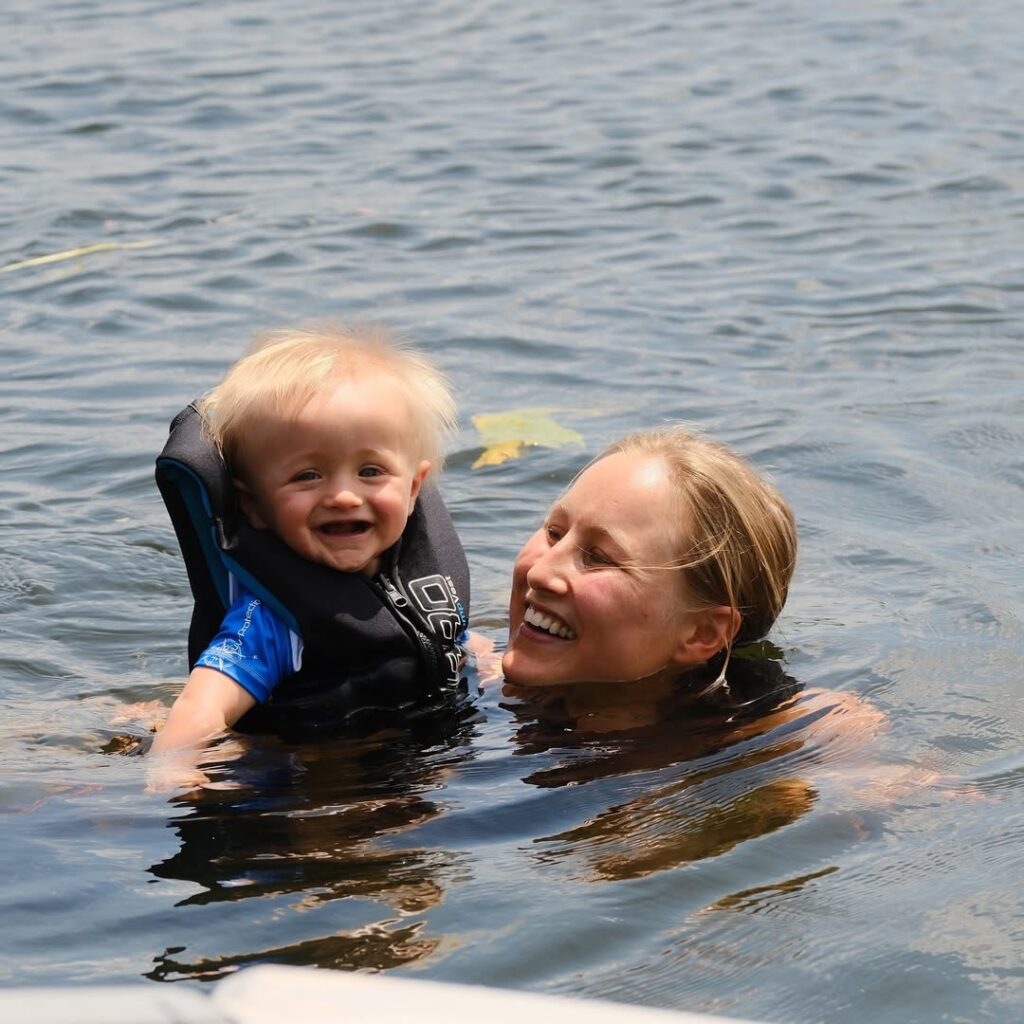
Image: @danemechler
Germany’s Giannina Bonnemann Mechler barely took a breath before getting back on the water. Nine months after welcoming her son, Luca, she’s already chasing elite form again. Earlier this year, she cracked the final at the Swiss Pro Tricks and secured qualification for the U.S. Masters with a score flirting with 10,000 points — a benchmark reserved for the sport’s upper echelon.
In 2023, Bonnemann Mechler went undefeated on the WWS Overall Tour and earned silver at the World Championships. One of only six women to trick over 10,000 points, her scores across all three events have sparked whispers of a potential challenge to Natallia Berdnikava’s longstanding world overall record. With her husband, top-ranked slalomer Dane Mechler, by her side and Luca in tow, Giannina’s comeback arc is one to watch.

Image: @action_horizons_stunts
If you blinked, you might have missed Jacinta Carroll’s tenure as an elite waterski mom — but what a flash it was. Just 100 days after giving birth to her daughter, Amelia, Carroll captured her 10th consecutive Moomba Masters jump title. It also served as her swan song: she announced her retirement from competition immediately after the victory.
Carroll’s résumé is staggering: 42 consecutive professional victories, five straight world titles (2013–2021), and the first woman to jump 200 feet. Known affectionately as “Rabbit,” she dominated women’s jumping from her teenage years, rarely losing and often setting records while doing so. Her final victory — achieved with just two weeks of on-water training post-pregnancy and the support of an international recovery team — was a fitting finale for an athlete who made a career of redefining boundaries in the sport.
As Carroll put it bluntly to other new mothers eyeing a quick return: “Don’t try this at home.” But whether they do or don’t, her legacy — like those of the other mothers on this list — has already expanded the definition of what’s possible.